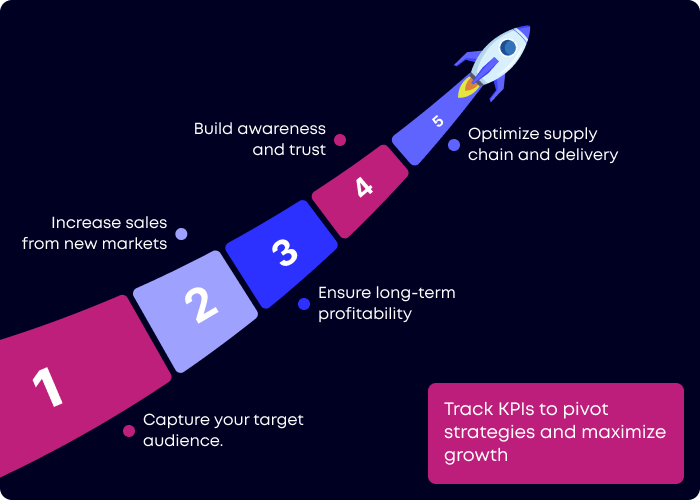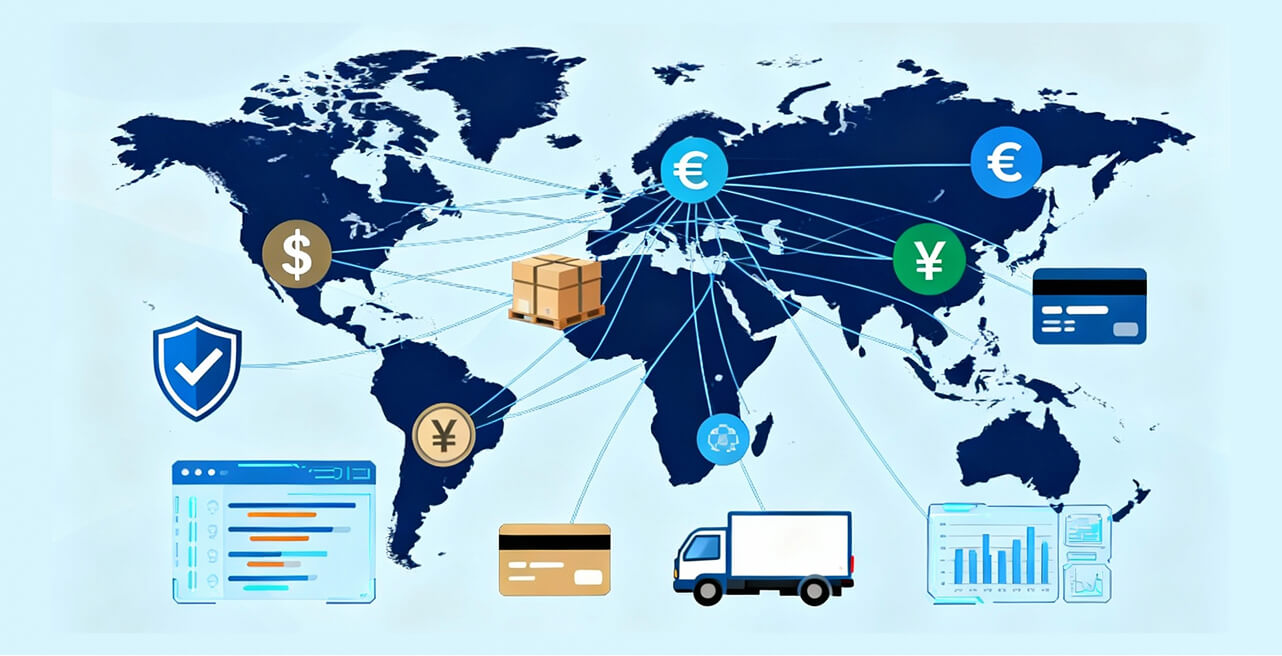Introduction
Expanding a business internationally is both an exciting opportunity and a complex challenge. Companies that succeed in one market often face significant hurdles when attempting to scale into new territories. Global market expansion requires careful planning, understanding local dynamics, adapting strategies, and leveraging technology and partnerships.
This guide explores strategic approaches to entering both emerging economies and mature markets, providing actionable insights for businesses seeking growth beyond their domestic borders.
Understanding Global Market Expansion
Global market expansion is more than just selling products internationally—it’s about creating sustainable operations, understanding local consumer behavior, complying with regulations, and adapting to different competitive landscapes. Companies expanding globally need to assess market potential, operational feasibility, and long-term strategic alignment with their goals.

Key components of global market expansion include:
- Market Research: Evaluating demand, competition, pricing, and customer needs.
- Regulatory Compliance: Understanding local laws, tariffs, trade restrictions, and tax implications.
- Operational Strategy: Deciding on supply chains, distribution, staffing, and local partnerships.
- Cultural Adaptation: Tailoring products, services, and marketing to fit local cultural norms.
Understanding these components helps companies make informed decisions about which markets to enter and how to approach them.
Entering Emerging Economies
Emerging economies offer enormous growth potential due to expanding consumer bases, rising incomes, and improving infrastructure. However, they also pose unique challenges including political instability, currency fluctuations, and regulatory complexity. Successful expansion in these markets requires a nuanced approach.

1. Market Research and Selection
Choosing the right emerging market involves more than identifying high GDP growth. Consider the following:
- Consumer Behavior: Understand preferences, purchasing power, and unmet needs.
- Market Size and Growth Potential: Evaluate both current market size and projected growth.
- Ease of Doing Business: Factor in bureaucratic hurdles, regulatory complexity, and infrastructure.
- Competitive Landscape: Identify local and international competitors, and potential gaps in the market.
For example, consumer tech companies entering Southeast Asia often focus on mobile-first strategies due to widespread smartphone usage, even in regions with lower income levels.
2. Entry Strategies for Emerging Markets
There are several ways to enter emerging markets, each with its own advantages and risks:
- Joint Ventures and Partnerships: Collaborating with local companies can help navigate regulatory landscapes and build trust.
- Franchising or Licensing: Allows brands to expand with lower capital investment while leveraging local expertise.
- Direct Investment: Establishing wholly-owned subsidiaries can offer full control but requires significant resources and risk management.
- Exporting: Exporting products without setting up local operations can be an initial step to test market demand.
3. Adapting to Local Culture and Consumer Preferences
Emerging markets often require companies to rethink their product offerings and marketing strategies. For instance:
- Adjust pricing strategies for affordability without compromising brand value.
- Localize marketing campaigns to reflect cultural nuances and social trends.
- Consider alternative distribution methods such as mobile payment platforms, informal retail networks, or digital marketplaces.
4. Risk Management in Emerging Economies
Operating in emerging markets comes with specific risks that need proactive strategies:
- Political and Regulatory Risk: Stay updated on local laws, taxation, and foreign investment policies.
- Currency Risk: Hedge against fluctuations if revenues and expenses occur in different currencies.
- Infrastructure Risk: Plan for potential logistical challenges related to transportation, supply chain, or digital connectivity.
Expanding into Mature Markets
Mature markets, such as the United States, United Kingdom, Germany, and Japan, are highly attractive for global expansion. They provide stable business environments, predictable demand, and well-established infrastructure, making them ideal for companies seeking consistent growth. However, these markets also come with intense competition, sophisticated customers, and high expectations. Success in such environments requires careful planning, differentiation, and a strategic approach to positioning.

1. Market Analysis and Segmentation
Expanding into mature markets begins with thorough research and detailed market insights. Companies need to understand both consumer behavior and competitive dynamics:
- Market Saturation: Mature markets are often crowded, with multiple players competing for similar customer segments. Identifying gaps or underserved niches can reveal opportunities where a brand can stand out.
- Consumer Expectations: Customers in mature markets typically expect premium quality, excellent customer service, transparency, and social responsibility from brands. Meeting these expectations is non-negotiable.
- Regulatory Environment: These markets often have stringent compliance standards, covering product safety, environmental regulations, data privacy (such as GDPR in Europe), and employment law. Non-compliance can result in fines, reputational damage, or operational setbacks.
Segmentation strategies are critical. Brands can focus on niche audiences, such as eco-conscious buyers, or target value-conscious consumers who seek high-quality products at competitive prices. Proper segmentation allows brands to tailor messaging, pricing, and offers, maximizing impact in a crowded landscape.
2. Entry Strategies for Mature Markets
Entry into mature markets requires strategic, differentiating approaches to gain a foothold:
- Acquisitions: Purchasing an existing player provides instant access to an established customer base, local expertise, and operational infrastructure, reducing the risk of slow market penetration.
- Strategic Partnerships: Collaborating with local brands, distributors, or retailers can accelerate entry, increase brand visibility, and provide insights into consumer behavior and cultural nuances.
- Direct-to-Consumer (DTC) Models: Building a strong online presence allows brands to reach consumers directly, bypassing traditional retail constraints and offering personalized experiences, faster delivery, and flexible payment options.
- Localized Branding and Marketing: Tailoring campaigns to resonate with local values, cultural norms, and buying behavior is essential. This may involve adjusting messaging, visuals, or promotional tactics to align with local expectations and preferences.
3. Leveraging Technology and Data
Mature markets provide access to advanced digital infrastructure and sophisticated consumer data, which can be leveraged for smarter expansion:
- Customer Data Analytics: Understanding customer behavior, preferences, and purchasing trends enables hyper-targeted marketing, personalized recommendations, and optimized product offerings.
- Marketing Automation: Streamlines campaigns across multiple channels—email, social media, search ads—ensuring consistent messaging, higher engagement, and cost efficiency.
- E-commerce Platforms: Advanced platforms allow businesses to scale sales quickly, manage inventory efficiently, and provide seamless shopping experiences without significant physical retail investments.
4. Competition and Differentiation
In mature markets, competition is fierce, and differentiation is crucial:
- Highlight Unique Value Propositions: Focus on aspects like sustainability, quality, innovative design, or exclusive features that set the brand apart.
- Exceptional Customer Experience: Beyond products, prioritize after-sales service, support responsiveness, and seamless fulfillment, which often become decisive factors for loyal customers.
- Build Brand Credibility: Certifications, awards, and endorsements from trusted organizations reinforce trust, signaling reliability to consumers who may already be loyal to established brands.
Why It Matters:
Expanding into mature markets is not just about offering a competitive product—it’s about understanding sophisticated customer expectations, leveraging technology, and creating a differentiated, credible brand presence. Companies that strategically analyze, localize, and innovate are more likely to convert these markets into profitable, long-term growth engines, while those who underestimate competition and consumer sophistication may struggle to gain traction.
Strategic Considerations for Both Emerging and Mature Markets
“Combine strategy, ethics, and technology to excel in both emerging and mature markets.
While the challenges of emerging and mature markets differ, there are several universal strategies that companies must prioritize to succeed in any global expansion:
1. Cultural Intelligence
Understanding local customs, traditions, values, and business etiquette is critical to building strong relationships and trust with customers, partners, and employees. In emerging markets, cultural awareness can help navigate informal business networks, while in mature markets, it can guide brand messaging, marketing campaigns, and customer engagement. Companies that invest in cultural intelligence are better equipped to avoid missteps, enhance communication, and connect authentically with local audiences.
2. Agile Operations
Global expansion demands flexible and responsive operational capabilities. Supply chains, marketing strategies, and sales channels must be able to adapt quickly to local conditions, whether it’s regulatory changes, market trends, or unexpected disruptions. Agile operations enable companies to respond effectively to both opportunities and challenges, minimizing risks and maintaining competitiveness across diverse markets.
3. Digital Readiness
Technology is a key enabler of global growth. Leveraging digital tools for market research, consumer insights, logistics management, and analytics ensures informed decision-making and efficient execution. From CRM systems that unify customer data across regions to e-commerce platforms that scale rapidly, digital readiness allows brands to operate with visibility, speed, and precision, regardless of the market environment.
4. Sustainability and Ethics
Today’s global consumers are increasingly conscious of ethical practices, responsible sourcing, and environmental stewardship. Brands that demonstrate genuine commitment to sustainability—not just as marketing messaging—build trust, credibility, and long-term loyalty. This applies to both emerging and mature markets, where customers are progressively rewarding businesses that align with their values and penalizing those that ignore social responsibility.
5. Talent and Leadership
Hiring local talent or establishing culturally aware leadership teams is essential for successful execution. Local employees provide insight into market behavior, language nuances, and cultural norms, while leadership with global experience ensures alignment with the company’s strategic vision. By combining local expertise with global oversight, businesses can make faster, smarter decisions and implement strategies that resonate across regions.
Why It Matters:
Regardless of whether a company is entering a fast-growing emerging market or a highly competitive mature market, success depends on a combination of cultural awareness, operational agility, technology adoption, ethical commitment, and local expertise. Companies that embrace these universal strategies are better positioned to mitigate risk, capture market share, and build sustainable global growth, turning expansion challenges into opportunities for long-term success.
Real-World Case Studies by Filuet
1. Launching a Smart Vending Machine for Seamless Offline Sales
To bridge the gap between digital convenience and physical retail, Filuet helped a client launch a smart vending machine as a 24/7 self-service sales channel. This innovative solution transformed the shopping experience by offering high accessibility and minimal operational overhead.
2. Simplifying Global Expansion Through Cyprus: A Legal and Financial Gateway
Filuet utilized Cyprus as a strategic hub to simplify global expansion for a client, addressing legal, financial, and regulatory challenges. By introducing a single master service agreement under UK-based jurisdiction, Filuet provided a well-known, business-friendly legal framework, facilitating smoother international operations.
3. Consistent Cross-Channel Brand Identity and Social Media Support
Filuet assisted a client in maintaining a consistent brand identity across various channels by streamlining content creation and enhancing content management. Sales distributors gained access to pre-designed visuals and localized content ideas, ensuring a cohesive identity and efficient content updates across all platforms.
4. Automated Retail Stores for Herbalife
Filuet addressed challenges in retail automation for Herbalife by implementing smart vending machines in high-traffic areas. These automated retail stores brought products closer to the point of demand, allowing for faster and more efficient order fulfillment, thereby enhancing customer experience.
Metrics for Measuring Success in Global Expansion

Monitoring key performance indicators (KPIs) is crucial to understanding whether expansion strategies are effective:
- Market Penetration: Share of target market captured.
- Revenue Growth: Sales increase from new markets.
- Customer Acquisition Cost (CAC) vs. Lifetime Value (LTV): Ensures profitability in the long run.
- Brand Recognition: Awareness and perception in new markets.
- Operational Efficiency: Supply chain reliability, delivery times, and cost optimization.
Regular evaluation allows companies to pivot strategies, allocate resources efficiently, and maximize returns on investment.
Challenges and Pitfalls to Avoid
Expanding globally is inherently risky. Common pitfalls include:
- Underestimating Cultural Differences: Misaligned products or messaging can result in poor reception.
- Ignoring Local Regulations: Non-compliance can lead to fines, reputational damage, or operational setbacks.
- Overextending Resources: Expanding too quickly without adequate planning can strain finances and management.
- Neglecting Local Competition: Failing to account for strong local players can undermine market entry efforts.
- Poor Localization: Products and services that do not meet local expectations can fail regardless of brand reputation.
Avoiding these pitfalls requires research, planning, and continuous learning from both successes and failures.
Conclusion
Global market expansion presents immense opportunities for revenue growth, brand visibility, and long-term sustainability, but it also comes with a set of complex challenges that require thoughtful planning and execution. Successfully entering new territories, whether emerging economies with fast-growing consumer bases or mature markets with high competition, demands strategic thinking, deep cultural understanding, and operational excellence at every stage of the expansion journey.
Companies that approach global markets with careful research, data-driven insights, and flexible strategies are better equipped to anticipate challenges, adapt to local conditions, and seize opportunities. A customer-centric mindset, where the focus is on understanding and meeting local preferences, expectations, and behaviors, is critical for building trust and driving loyalty across borders.
Filuet partners with businesses navigating these complexities, offering tailored insights, practical solutions, and actionable strategies to optimize global expansion efforts. By leveraging Filuet’s expertise, companies can streamline market entry, improve operational efficiency, and enhance customer experiences, ultimately transforming the challenges of international growth into sustainable success.
FAQs: Global Market Expansion Strategies
1. What is the difference between expanding into emerging markets and mature markets?
Emerging markets offer high growth potential but come with challenges like regulatory complexity, political instability, and infrastructure gaps. Mature markets, on the other hand, provide stable environments and predictable demand but have intense competition and sophisticated customer expectations. Both require tailored strategies to succeed.
2. How should companies decide which international market to enter first?
Market selection should be based on a combination of factors—consumer demand, competitive landscape, regulatory ease, cultural compatibility, and logistical feasibility. Conducting thorough market research and pilot testing can help identify the most strategic entry point.
3. What are the most effective entry strategies for global expansion?
Common strategies include exporting, franchising, joint ventures, acquisitions, and establishing local subsidiaries. The right approach depends on the company’s resources, risk appetite, and long-term goals. For instance, partnerships are ideal for emerging markets, while acquisitions or DTC models may suit mature markets better.
4. Why is cultural adaptation critical in global expansion?
Cultural adaptation ensures that products, services, and marketing resonate with local audiences. Misalignment with cultural norms can lead to poor brand perception or product rejection. Companies that localize messaging, design, and experience often see higher engagement and customer loyalty.
5. How can technology support successful market expansion?
Technology enables data-driven decision-making and operational efficiency. From AI-powered analytics and CRM systems to e-commerce and logistics platforms, digital tools help businesses track performance, optimize supply chains, and personalize customer experiences across regions.
6. What are the main risks involved in global market expansion?
Key risks include political instability, currency fluctuations, non-compliance with regulations, and underestimating local competition. A proactive risk management strategy—such as hedging, local partnerships, and compliance monitoring—can help mitigate these challenges.
7. How does sustainability influence global expansion success?
Consumers worldwide are increasingly drawn to brands that prioritize ethical sourcing, eco-friendly packaging, and carbon-neutral operations. Demonstrating genuine commitment to sustainability enhances trust, brand reputation, and long-term loyalty in both emerging and mature markets.
8. How can businesses measure the success of their global expansion strategy?
Key metrics include market share, revenue growth, customer acquisition cost (CAC), lifetime value (LTV), brand recognition, and operational efficiency. Regularly reviewing these KPIs helps companies identify gaps, adjust strategies, and ensure sustainable growth.
9. What role does Filuet play in supporting global market expansion?
Filuet partners with businesses to simplify and accelerate international growth. From legal and logistical frameworks to localized marketing, smart vending solutions, and digital integration, Filuet provides tailored strategies and execution support to help brands expand seamlessly and efficiently.
.webp)














